Table of Contents
Introduction
Medical Disclaimer: This article is for informational purposes only and does not replace professional veterinary advice. Always consult your veterinarian for guidance tailored to your pet.
If you’re a dog owner in 2025, staying informed about rabies isn’t just smart, it’s legally and medically essential. Rabies in dogs is nearly always fatal once symptoms appear, but entirely preventable with timely vaccination. In this guide, we’ll walk you through everything you need to know right now, from new global eradication efforts and Canadian legal rules to practical steps you can take to keep your dog, your family, and your community safe.
Key Takeaways
- Rabies in dogs is 100% preventable, yet it still kills tens of thousands worldwide each year.
- In Canada and most countries, rabies vaccination is legally required for dogs.
- To stop transmission, at least 70% of the dog population must be vaccinated annually.
- The “Zero by 2030” global campaign aims to eliminate dog-mediated rabies deaths within five years.
- Real-life success stories, like Beijing’s, prove elimination is possible with coordinated efforts.
- As a dog owner in 2025, your role is vital: stay compliant, report bites, and support local vaccination drives.
What Is Rabies in Dogs?
you can visit: https://doglifeexpert.com/5-kennel-cough-causes-and-treatment/
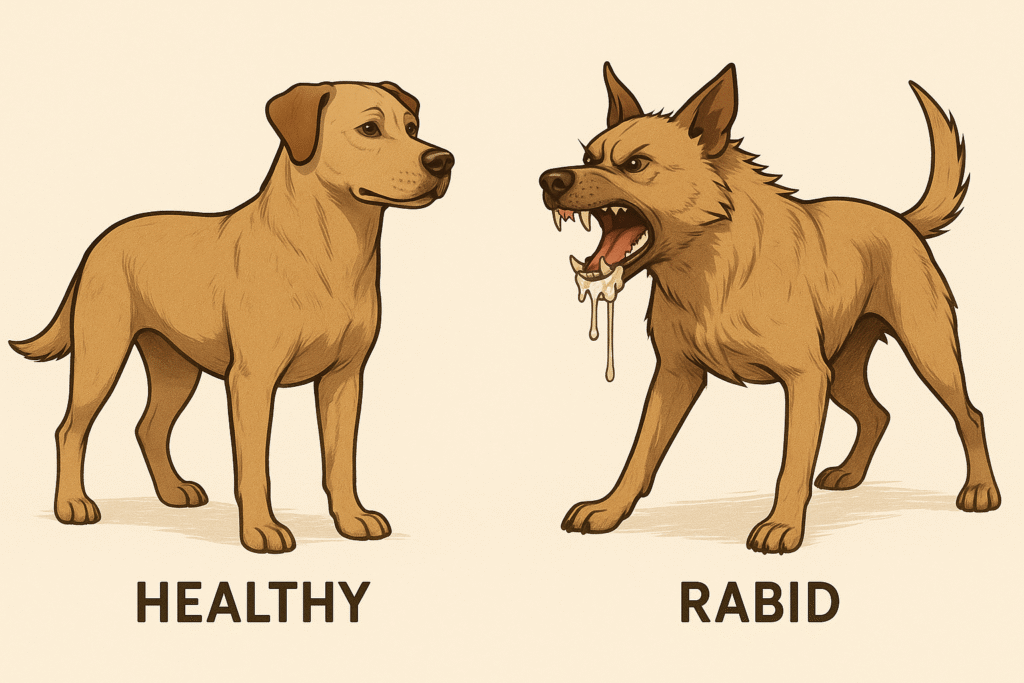
Rabies in dogs is a viral disease that attacks the central nervous system and is nearly always fatal once symptoms appear. It spreads through the saliva of infected animals, typically via bites. While rare in many parts of Canada thanks to strict vaccination programs, it remains a significant public health concern globally, even in 2025.
How Dogs Get Rabies
Dogs usually contract rabies through bites from infected wild animals like raccoons, skunks, foxes, or bats. The virus travels from the bite site along nerves to the brain, where it causes inflammation and, eventually, death.
Signs of Rabies in Dogs
Watch for these symptoms:
- Sudden behaviour changes: anxiety, aggression, or unprovoked fear
- Excessive drooling or foaming at the mouth
- Difficulty swallowing or vocalising
- Disorientation or staggering
- Seizures or paralysis (especially of the jaw or limbs)
Once these symptoms appear, there is no cure. That’s why prevention through vaccination is non-negotiable.
Why Vaccination Is Critical in 2025
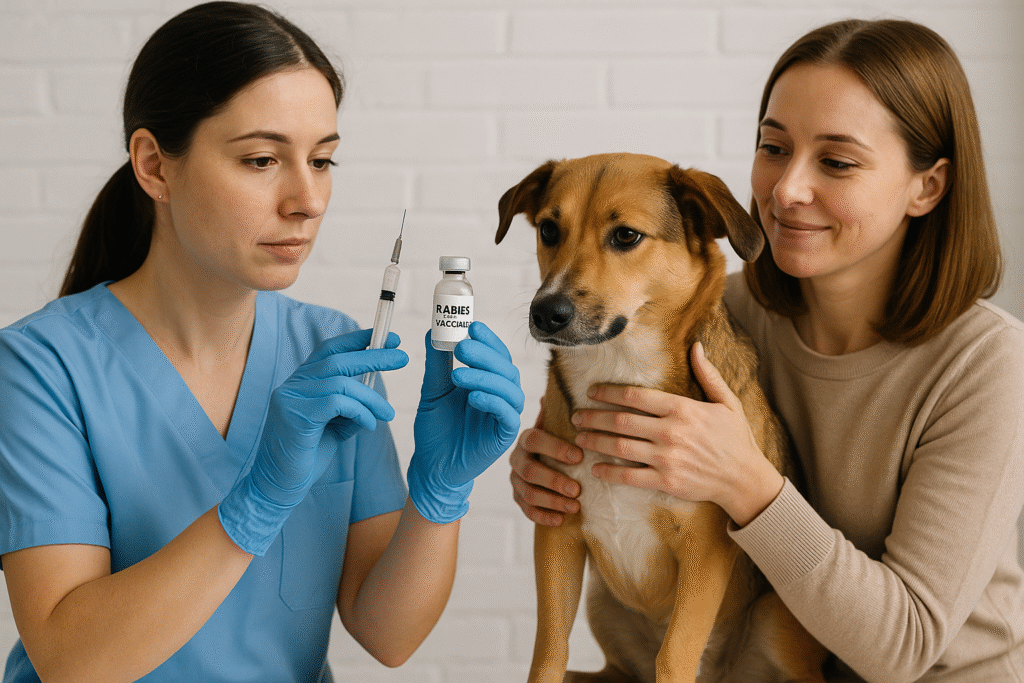
In 2025, rabies in dogs remains a top priority for public health officials, not because we lack the tools to stop it, but because coverage gaps persist. As a dog owner, keeping your pet’s rabies vaccination up to date is the single most effective thing you can do to prevent tragedy.
How Rabies Vaccines Work
Modern rabies vaccines stimulate your dog’s immune system to produce antibodies that neutralise the virus. According to the World Health Organisation, they are safe, long-lasting, and effective at both the individual and community levels.
When to Vaccinate
- First dose: Typically at 12–16 weeks of age
- First booster: After 1 year
- Ongoing boosters: Every 1 to 3 years, depending on vaccine type and provincial laws
Check with your vet about the vaccine used in your area and when your dog is due. Delaying even one booster can legally and medically compromise your dog’s protection.
Legal Requirements in Canada and Worldwide
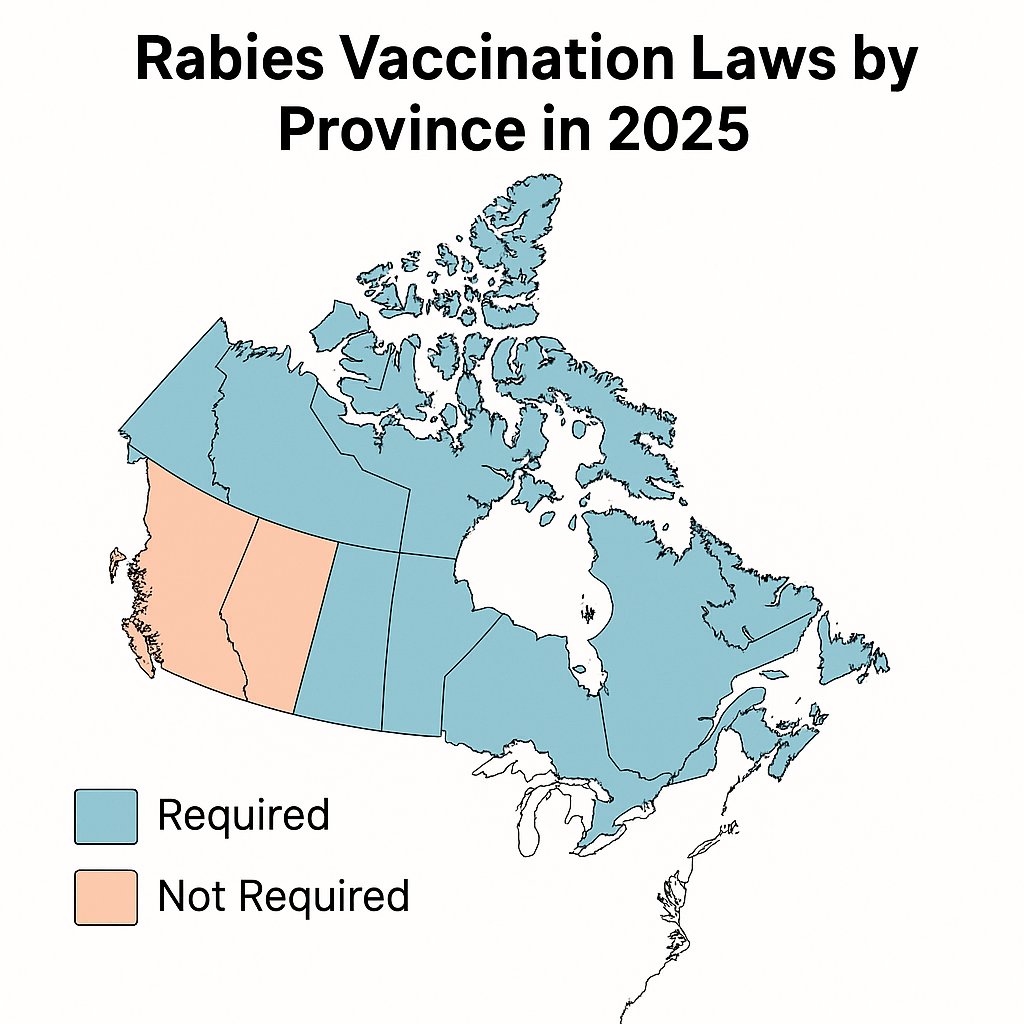
By 2025, rabies in dogs will remain tightly regulated across Canada and much of the world. Vaccination isn’t just recommended, it’s often the law. Failure to comply can lead to fines, liability after bites, or even mandatory quarantine or euthanasia for unvaccinated pets.
Rabies Laws by Canadian Province
| Province | Is Rabies Vaccination Mandatory? | Notes |
|---|---|---|
| Ontario | Yes | Required by law for dogs over 3 months |
| Quebec | Yes (in most municipalities) | Municipal bylaws vary |
| BC | No (but strongly recommended) | Required for travel or bite incidents |
| Alberta | No | Required by many municipalities |
| Nova Scotia | Yes | Provincial regulation applies |
| Manitoba | Varies by region | Check local bylaws |
Always check your municipal and provincial regulations many localities update rules annually, especially as part of broader rabies surveillance strategies.
International Comparisons
Some countries have even stricter protocols. For instance, Romania mandates not only rabies vaccination but also muzzling specific breeds in public. In contrast, some developing regions struggle to enforce vaccination due to resource limitations.
Global Strategy: “Zero by 2030”
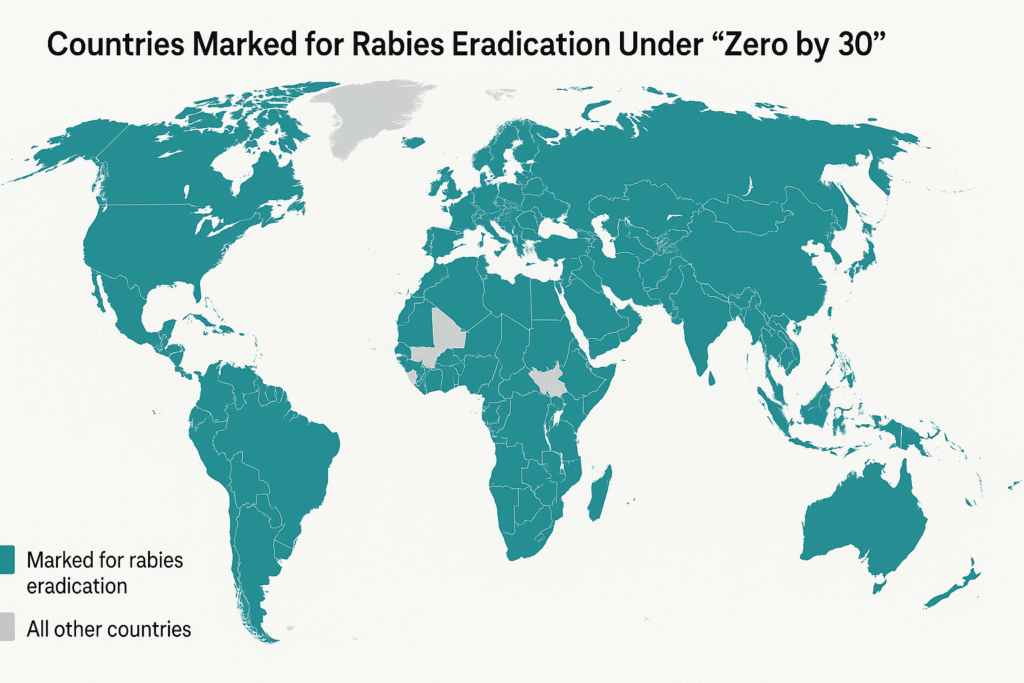
In 2025, the world is at a tipping point. With just five years left to meet the “Zero by 30” goal, eliminating dog-mediated human rabies is within reach but only if efforts accelerate.
What Is “Zero by 30”?
The “Zero by 30” initiative is a joint strategy led by the World Health Organisation (WHO), the Food and Agriculture Organisation (FAO), and the World Organisation for Animal Health (WOAH). It aims to eliminate all human deaths from rabies caused by dog bites by the year 2030.
Why It Matters for Dog Owners
This isn’t just a global goal it’s a local responsibility. Achieving “Zero by 30” relies on consistent rabies vaccination in dogs, rapid bite response, and public education at every level. According to Frontiers in Tropical Diseases, underreporting of rabies deaths remains a major barrier, especially in rural and underserved areas.
In short, your actions as a dog owner directly contribute to a global health milestone.
Vaccination Coverage: Why 70% Matters
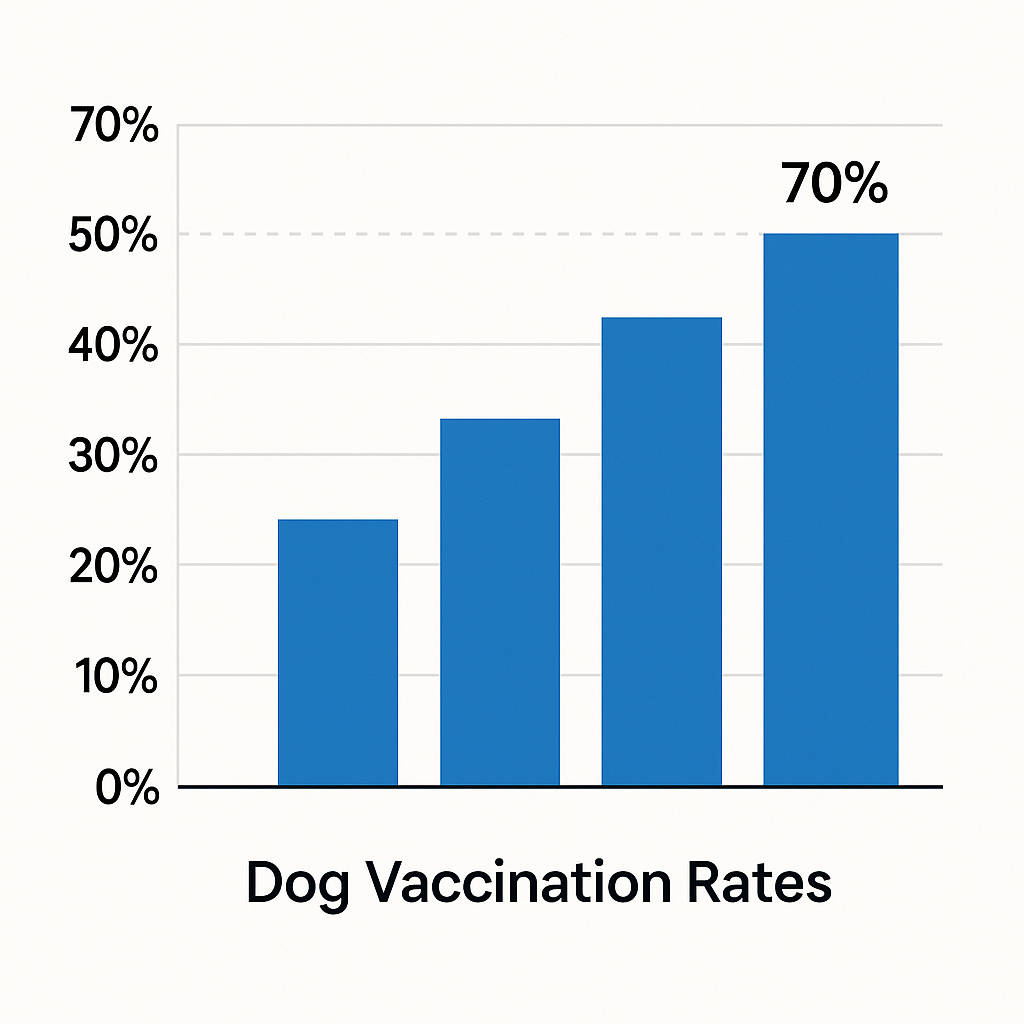
One of the most important facts about rabies in dogs is that eradication is not just theoretical it’s mathematical. Studies show that if 70% of a dog population is vaccinated, rabies transmission breaks down. That’s the magic number for herd immunity.
Why 70%?
Research from Frontiers in Veterinary Science confirms that 70% annual vaccination coverage sustained over multiple years can eliminate the virus in local canine populations. This threshold protects even unvaccinated dogs by interrupting chains of infection.
The Human Impact
A PLOS Neglected Tropical Diseases analysis in Latin America showed that every 10% rise in dog vaccination leads to a measurable drop in human rabies deaths. Simply put, vaccinating dogs saves human lives, especially children, who are most often victims of dog bites.
What This Means for You in 2025
Whether you live in downtown Ottawa or a rural community, your dog’s vaccination adds to this protective barrier. In 2025, many local health units track dog vaccination coverage as part of rabies surveillance, so ensuring your pet is up to date doesn’t just help them; it helps the entire region.
How Rabies in Dogs Was Eliminated in Beijing
One of the clearest signs that rabies in dogs can be controlled and even eliminated comes from Beijing. Between 2014 and 2023, the city launched an aggressive, multi-pronged approach that worked.
What Beijing Did Right
As detailed in this ResearchGate study, Beijing’s program included:
- Mandatory dog registration and rabies vaccination
- Free or subsidised vaccines for eligible pet owners
- Digital tracking of vaccination status via mobile apps
- Public education campaigns through schools, clinics, and social media
- Active surveillance of both domestic and wild animal cases
The Results
- Vaccination coverage rose from 64.7% in 2014 to over 86% by 2017
- Zero human rabies cases from 2021 through 2024
- Strong public engagement and transparent data reporting
Takeaway for Canadian Dog Owners
Beijing’s success wasn’t based on high tech alone it was based on community compliance and consistent messaging. In 2025, many Canadian regions are adopting similar models, integrating rabies tracking with licensing apps and neighbourhood campaigns.
Governance: What Makes Rabies Control Work?
Behind every successful rabies eradication effort is a strong framework of cooperation. In 2025, public health professionals stress that controlling rabies in dogs is not just a veterinary issue, it’s a governance challenge.
What Works: The REDIPRA Model
In Latin America, the REDIPRA coalition has been pivotal. It brings together ministries of health, agriculture departments, veterinary organisations, NGOs, and donors to coordinate efforts across borders. This model has helped drive down human rabies deaths in countries like Mexico, Brazil, and Peru.
Global Collaboration: United Against Rabies
The United Against Rabies Forum offers tools, data, and policy templates for countries worldwide. Their first two years of activity created:
- Standardised rabies surveillance templates
- Bite case management guides for clinics
- Shared data repositories to identify vaccination gaps
What This Means for Dog Owners
In 2025, the ripple effects of these coalitions reach right to your doorstep. For example:
- Your vet may use a bite-risk protocol developed by the WHO
- Your province may get funding for mass vaccination based on global data
- Your dog’s rabies tag may be tracked in a national health registry
You’re part of a global safety net, and your compliance matters more than ever.
Barriers to Success and How to Overcome Them
While tremendous progress has been made, rabies in dogs remains entrenched in some regions due to ongoing barriers. Understanding these challenges helps dog owners recognise their role in overcoming them, especially in 2025, when global elimination is within sight.
Common Barriers
- Stray or free-roaming dogs: These animals are often unvaccinated and hard to reach.
- Lack of public awareness: Many pet owners underestimate rabies risks or skip boosters.
- Weak enforcement: In some provinces or countries, legal vaccination requirements aren’t monitored.
- Underreporting of bite incidents leads to missed cases and lost data on potential outbreaks.
Innovative Solutions
A study from arXiv revealed that simply placing vaccination sites within walking distance of communities significantly boosts coverage. Mobile clinics, school-based awareness campaigns, and partnerships with local animal control units are helping bridge access gaps.
The Global Alliance for Rabies Control also emphasises community empowerment educating pet owners, teachers, and local leaders to drive demand for vaccination.
What You Can Do in 2025
- Ask your municipality about mobile rabies clinics or low-cost vaccine days
- Volunteer during World Rabies Day (Sept 28) to promote awareness
- Report stray or unvaccinated dogs to animal services to support surveillance
Every action, no matter how small, helps push rabies toward extinction.
5-Minute Home Checklist for Rabies Prevention
Want to make sure your dog is protected against rabies in 2025? Use this quick checklist to confirm you’re on track:
✅ Check your dog’s vaccine certificate
- Is the rabies vaccination current?
- When is the next booster due?
✅ Review your local laws
- Is rabies vaccination legally required in your municipality?
- Do you need a rabies tag or license?
✅ Know what to do if your dog is bitten or bites someone
- Report to the local public health and your vet immediately
- Follow post-exposure protocols even if your dog is vaccinated
✅ Locate the nearest emergency vet
- Save the contact details in your phone
- Ask if they handle bite wound evaluations and rabies reporting
✅ Talk to your family
- Make sure everyone knows not to approach stray animals
- Teach kids how to avoid dog bites and when to tell an adult
This checklist takes five minutes but could save a life.
Typical Rabies Vaccination Costs in Canada (2025)
While some provinces offer subsidised programs, dog owners in Canada should budget for rabies vaccines as part of routine care. Here’s a 2025 snapshot:
| Province/Territory | Cost Range (CAD) | Notes |
|---|---|---|
| Ontario | $35–$60 | Often bundled with an annual exam |
| Quebec | $30–$55 | May vary by clinic and city |
| British Columbia | $40–$70 | Some mobile clinics offer discounts |
| Alberta | $35–$65 | Lower-cost options in rural areas |
| Nova Scotia | $30–$50 | Required by provincial law |
| Manitoba | $40–$65 | Check municipal bylaws for mandates |
| Saskatchewan | $35–$60 | Discounts available via SPCA events |
| New Brunswick | $30–$55 | Community programs available |
| Newfoundland & Labrador | $40–$60 | Some areas offer free public clinics |
| Territories | $45–$70 | Access may be limited; plan ahead |
Note: Prices include the vaccine only exam fees or licensing may be extra.
To reduce costs:
- Ask your vet about 3-year vaccines (if applicable)
- Check for pop-up vaccine clinics around World Rabies Day (September 28)
- Watch for community events hosted by SPCAs or animal health units
Practical Prevention Tips for Dog Owners in 2025
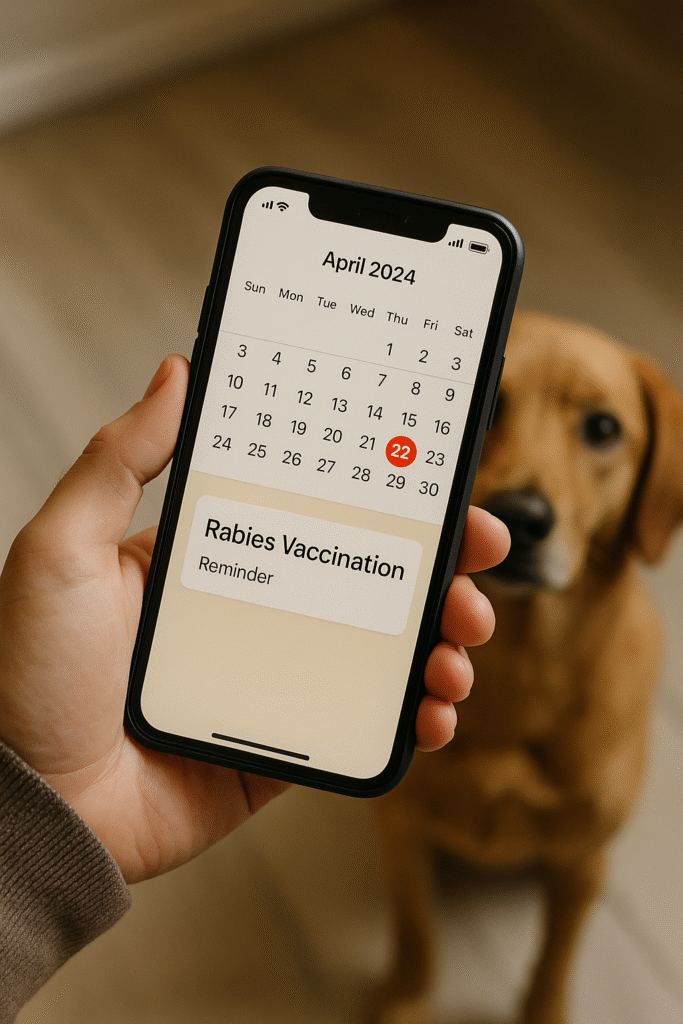
Rabies in dogs is still circulating in wildlife across Canada and globally. Here’s how you can reduce risk and stay legally and medically protected this year:
1. Stay Up to Date on Vaccinations
- Book your dog’s rabies booster before it expires.
- Keep documentation handy, it may be required for boarding, grooming, or travel.
2. Know Local Laws and Report Violations
- Understand your province’s vaccination and leash laws.
- If you see dogs roaming unvaccinated or witness bites, report it to your local bylaw office or health unit.
3. Avoid Contact with Wildlife
- Keep your dog on a leash in parks and near wooded areas.
- Never let pets interact with raccoons, skunks, or bats, rabies reservoirs in Canada.
4. Support Mass Vaccination Campaigns
- Encourage friends, neighbours, and community members to vaccinate.
- Participate in World Rabies Day (September 28) events or school awareness days.
5. Educate Your Family
- Teach children to avoid unfamiliar animals and to tell an adult if they are bitten or scratched.
- Help older adults understand how to respond if a pet or person is bitten.
These steps are small but powerful contributions to Canada’s and the world’s 2025 rabies control goals.
❓ FAQs About Rabies in Dogs (2025)
1. Is rabies still a threat in Canada in 2025?
Yes, though rare, rabies is still detected in wildlife reservoirs like raccoons, skunks, and bats. Dog vaccination remains crucial to preventing its return in domestic animals.
2. How often do dogs need rabies shots in Canada?
Typically, dogs get their first rabies vaccine at 12–16 weeks, a booster one year later, then every 1 to 3 years, depending on the vaccine type and provincial law.
3. Can a vaccinated dog still get rabies?
It’s extremely rare. While no vaccine is 100% effective, properly vaccinated dogs have very strong protection. Breakthrough cases usually involve improper storage, overdue boosters, or unusual exposure.
4. What happens if my dog bites someone?
You must report it to your local public health authority. If your dog is vaccinated, they may be quarantined and monitored for symptoms. Unvaccinated dogs may face stricter consequences, including potential euthanasia.
5. What should I do if my dog is bitten by a wild animal?
Get your dog to a veterinarian immediately even if they’re vaccinated. A post-exposure booster may be required, and the incident should be reported to animal control and public health.
6. Does Canada still require rabies vaccines for travel in 2025?
Yes. Dogs travelling between provinces or entering Canada from abroad must have proof of current rabies vaccination. Check CFIA and provincial rules before travel.
Summary: Rabies in Dogs 2025
- Rabies in dogs is preventable, but still deadly, and still relevant in 2025.
- Canadian laws require dog vaccination in most provinces, and enforcement is tightening.
- To achieve global eradication through the Zero by 2030 initiative, dog owners must ensure 70%+ vaccination coverage is maintained.
- Cities like Beijing have proven that dog-mediated human rabies can be eliminated through coordinated efforts.
- As a dog owner in 2025, your role is vital:
✅ Keep vaccines up to date
✅ Follow local bite and leash laws
✅ Participate in awareness and prevention programs
Rabies may be ancient, but in 2025, we’re closer than ever to ending it, starting with your dog, your neighbourhood, and your actions today.


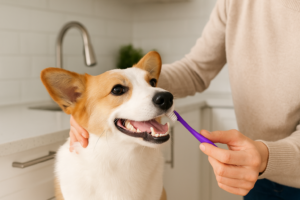

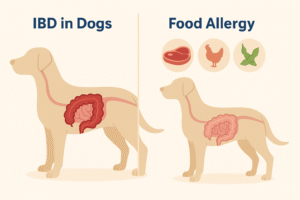
Pingback: Top 10 Reasons the Leptospirosis Vaccine in Dogs Saves Lives in 2025
Pingback: International Dog Travel: 7 Steps for a Safe Trip